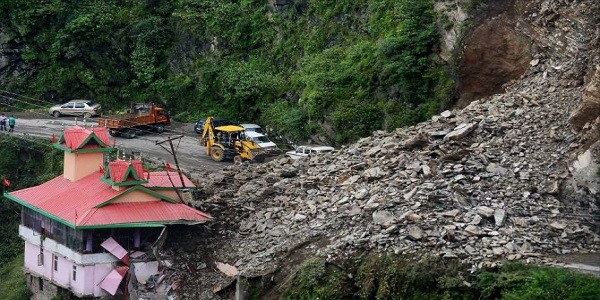[Disaster Series] Landslides in India and its Management

Humans have always had to face the impact of natural hazards. Natural hazards account for up to 4 percent of the annual deaths worldwide, besides causing enormous economic losses and habitation losses. Landslides are a significant type of natural disaster that affects most of the hilly regions.
What are Landslides?
Landslides are a downward and outward movement of slope materials like rock debris and earth, under the influence of gravity. when the shear stress exceeds the shear strength of the material, the down-slope movement of the mass of rocks & debris initiates.
What are the types of landslides?
- Falls
Falls are sudden movements of masses of geologic materials that become detached from steep slopes and cliffs. Movement occurs by free-fall, bouncing and rolling. Depending on the earth’s material type involved, the result may be rockfall, soil fall, debris fall, earthfall, boulder fall, and so on.
- Topple
A topple may be a block of rock that tilts or rotates forward on a pivot or hinge point and then separates from the main mass, falling to the slope below.
- Slides
Movements of soil or rock along a definite surface of rupture which separates the slide material from the more stable underlying material. The two main types of landslides are rotational slides and translational slides.
What are the causes of Landslides?
Morphological causes
- Ground Uplift because of volcanic or tectonic disturbances.
- Erosion of slope due to wind or water.
- Vegetation removal by forest fires, drought.
Physical causes
- Prolonged precipitation within the hilly regions (Nilgiri hills)
- Rapid drawdown because of precipitation (Western ghats overlooking Konkan coast)
- Artesian pressure is also a reason for Landslide.
- Earthquake and volcano eruption.
Anthropogenic causes
- Largescale excavations especially at the toe of slopes.
- Deforestation for developmental activities.
- Large constructions like Dams, Hydroelectric power plants, Tunnels, etc.
- Vibrations caused due to Mining.
- Water impoundments and leakage from reservoirs.
What is the difference between a landslide and avalanche?
An avalanche occurs during winter. Avalanche is the movement of a large mass of ice or snow down the slow. Avalanches occur in mountainous regions with a thick snow cover but a landslide happens in sloppy places with loose and muddy soil. Landslides involve the movement of a very large mass of earth down a slope and they can be caused by various factors such as poor soil structure, rainfall, drought, erosion, and seismic activities. An avalanche can be caused by vibrations from an earthquake or in severe conditions loud sounds can disrupt the snow.
What are the impacts of Landslides?
- Huge losses of life and property
-
- Guwahati Landslide (1948)- 500 deaths
- Malpa Landslide (Uttarakhand, 1998)- around 400 deaths
- Mumbai Landslide (2000)- 67 deaths
- Kedarnath (2013)- over 5700 reported deaths and 4200 villages were affected
-
- Decimation of infrastructure
The force flow of mud, debris, and rocks because of a landslide can cause serious damage to property. Infrastructure like roads, railways, leisure destinations, buildings and communication systems are often decimated by a single landslide.
- Impacts on the river systems
The material sliding downhill can intrude into rivers and block their natural flow. River lifelike fish can die because of the interference of natural flow of water. Communities counting on the river water for household activities and irrigation will suffer if the flow of water is blocked.
- Landscape beauty is affected
The erosion left behind by landslides leaves behind rugged landscapes that are unsightly. The pile of material that comes downhill can cover land utilized by the community for agricultural or social purposes.
Susceptible regions in India
- Landslides are a natural hazard that affects around 15 percent of the land area of our country, covering an area larger than 0.49 million sq. km.
- The Himalayan mountain ranges and hilly tracts of the North-Eastern region are highly vulnerable to the instability of slope because of the immature topography, fragile rock conditions, high seismicity resulting from proximity to the plate margins and rainfall.
- Similarly, the Western Ghats, overlooking the Konkan coast, though located in the relatively stable domain, experience the fury of this natural hazard due to steep hill slopes, overburden and high-intensity rainfall.
- The Nilgiri hills located at the convergence zone of the Eastern Ghats and the Western Ghats face the events of landslides due to their location in a zone of high intensity and protracted rainfall where the overburden is sensitive to over-saturation.
- In addition to landslides, the snow avalanche is another natural hazard involving mass movement that is experienced at high altitudes within the Himalayan terrain during the late winter season when the snow starts melting.
Land management in India
- Landslide hazard management in India was very ad-hoc with solutions for site-specific problems and the implementation of immediate remedial measures including debris removal, and dumping of this debris either downslope or into a river.
- The NDMA in 2009 published the guidelines for landslide management. Accordingly, the main components of landslide management are
- After the Malpa incident, the Government set up task forces for Landslide Hazard Zonation (LHZ), Geotechnical Investigation and Land Use Zonation and Regulation.
- The Geological Survey of India (GSI) was given the responsibility of nodal agency for LHZ and the Department of Science and Technology (DST) and the Ministry of Environment and Forests and climate change (MoEFCC) were identified as nodal agencies for the remaining two task forces, respectively.
- The GSI is the lead agency for landslide monitoring and mitigation.
- The Landslide Hazard Atlas of India containing small scale maps was published jointly by the Building Materials and Technology Promotion Council (BMTPC) and Anna University in 2004.
- Since 2014 – 15, GSI has launched and undertook a national programme on landslide susceptibility mapping – Macro scale (1:50,000) National Landslide Susceptibility Mapping (NLSM) with an aim to cover the 0.42 million sq. km landslide-prone areas of the country.
Prevention measures for landslides
- Personal measures
- Reinforcement of floor slabs and external walls in existing buildings.
- Installation of drainage pipes for rainwater, slope drainage.
- Planting of slopes that are vulnerable to landslides with deep-rooted trees and shrubs.
- Technical/Biological measures
- Drainage and/or grading of slope profiles increase the shear resistance
- The stability of slopes can be substantially increased by reducing a load of soil at the crown or by its enlargement at the toe of the landslide. According to estimates if 4% of scrapping volume is displaced, its stability is increased by 10%
- Supporting structures such as anchors and piles (pinning of the slip plane) can restrain landslides
- Removal of material in the ‘driving’ section, or material deposition in the ‘braking’ section, can prevent further descent of the sliding body
- Retaining walls can be built to impede the motion of sliding material.
What are the issues in Landslide management in India?
- The CAG reported the lack of communication systems during the Uttarakhand landslides which aggravated the problems.
- The issue of coordination and administration at different levels is still lingering.
- The appropriate interpretation of the meteorological forecast is still lacking.
- The inappropriate hill area development including unscientific construction of roads, tunnels, hydroelectric projects do a lot of damage to the natural balance of the structures.
- Illegal encroachment of the rivers is still not contained through appropriate actions.
- The economics of tourism weighs high above sustainable development in policymaking.
- Weak environmental impact assessment regime is in part responsible for increases problems.
- Lack of funds for mitigation and prevention measures is another area of concern.
- Every time a huge disaster occurs, the first few hours are wasted in calling NDRF. The local and state SDRF is not trained enough to handle huge disasters.
- There is a lack of scientific analysis of landslide events and inventory of data analysis which makes mistakes recurring.
What must be done further to contain the menace of landslides?
- Implementation of hazard zone mapping and flood plain zoning must be done on a war footing.
- The legal framework needs to be developed to avoid construction on unstable slopes without vulnerability studies.
- Hydropower projects must be balanced with critical local environmental needs.
- The developmental projects must be carried only after a proper Environmental Impact Assessment.
- Landslide risk micro-zonation using ground truth of landscape, geology, ecology, vegetation, soil characteristics, human settlements, landslide and flood history of the site is a must.
- Blasting for developmental activities must be regulated as frequent blasting may destabilize the weak surface.
- Unsustainable mining of the riverbeds and illegal mining must be stopped immediately
- Review of the alignments of existing roads according to scientific analysis.
- Separate evacuation routes must be constructed for major pilgrim centres.
- Standard Operating Procedures (SOPs) for mitigation, preparedness and response must be prepared for all major disasters with clear duties and responsibilities to stakeholders.
- Coordination and augmentation of wireless, satellite and ham radio communication systems for carrying out effective response and rescue operations in case of a disaster.
- The carrying capacity of tourism sites should also be kept in mind while planning for tourism-related developmental activities.
- Comprehensive training on multitudes of aspects of disaster management for all the stakeholders and role-players is inevitable.
- The State Government should appoint an officer as Nodal Officer in each district, for effective coordination with NGOs and other voluntary agencies.
- Medical relief plans should also be included in disaster response plans and resources assigned likewise.
- There is an urgent need for trained volunteers for psychological assistance after the disaster has occurred.
Landslide is a disaster that occurs in the areas of least development and less accessibility. Proper planning and management of mitigation and prevention strategy are important in minimizing the losses due to the disaster. The real challenge is to control the landslides to natural causes and minimize the human triggers of landslides. This can be done by accommodating sustainable solutions to impending development programs.
Practice Question for Mains
What are landslides? Enumerate the causes of landslides and suggest suitable measures to contain its menace. (250 words)
If you like this post, please share your feedback in the comments section below so that we will upload more posts like this.

